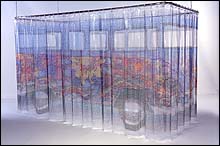Denver Post
February 10, 2003
"Artists
Shine in Shared Show"
by Kyle MacMillan
(PHOTOGRAPH
SCALED DOWN ON WEB SITE)

Two and three dimensions. Old and new technologies.Perception and reality.
The interplay between these elements provides the foundation for an absorbing exhibition that continues through Feb. 20 at the University of Denver's Victoria H. Myhren Gallery.
It is the essential link between the two nationally known artists featured, who in many other ways differ considerably in their approaches, hence the title "Duality/Autonomy."
"In Devorah Sperber and Clark Richert we have an opportunity to observe how two established, thoughtful contemporary artists reconcile questions of perception, image making and the role of technology in art," writes Jeffrey Keith, a member of DU's art faculty who curated the show.
Sperber, a former Denverite who graduated from Regis University in 1987 and now lives in New York City, has generated considerable recognition in the art world.
It is easy to see why. Her sculptures resonate with a sparkling originality. She tinges everything with a playful pop sensibility and tricks the eye and challenges perceptions with the unexpected forms the works take.
The centerpiece of her portion of the show is "VW Bus: Shower Power," an attention-grabbing piece, which made its debut in March 2002 at New York's Graham Gallery in a show whimsically titled "Bikinis, Bandanas and VW Bus."
The basic shape and colors of the hippie van are outlined on clear plastic shower curtains, using thousands of tiny, colored flower stickers. The plastic is draped on a curved rectangular-shaped rack hanging from the ceiling as over a giant bathtub.
Though the van is rendered in decidedly flat fashion on the plastic, the shower curtain has enough of a form that, from an appropriate distance, the eye fills in the details and conjures the basic three-dimensional image of the van.
To arrive at the intricate arrangement of the thousands of stickers, which are essentially low-tech pixels, she began with a photograph of a VW van that she digitally dissected into its minute color components.
Thus in this one work can be found all the basic dualities inherent in this show, none more obvious than the liquid, ill-defined crossover between two- and three-dimensionality.
Two other of her works that demand mention are "String Bikini" and "Thong Bikini," with their American flag designs. The wall sculptures turn out in reality to be quite different from the way they look in photographs, each actually made of hundreds of push-tacks arranged in clear vinyl.
The sheer unexpectedness of this choice of materials makes these works striking, not to mention the tantalizing tactile incongruity of prickly tacks making up something that in reality should be easy on the skin.
But what really sells these pieces is the realization that comes after some moments that, in another of Sperber's visual games, they are essentially the inverse of each other. Or to put it differently, one of the pieces shows the outside of a bikini, the other the inside.
Richert, one of Denver's most respected veteran painters, uses the traditional, two-dimensional form of paint on canvas to explore the expansive three-dimensionality of the universe.
Among the many dualities in his work is the contrasting exactitude of the scientific and mathematical elements he incorporates versus the inevitable inexactitude and intangibility of artistic and creative expression.
Richert has devoted much of his life to the study of such geometrical concepts as "nuark coding," "triacon complex" and "octaval complex," which he attempts to express in artistic terms.
Four of the six paintings on view are from his 2002 "Turbulence" series, in which he is dealing with the constant competition in nature between stasis and turbulence.
Thus in "R-P Motion," dashed lines in the full spectrum of colors serve as the "turbulence," snaking randomly over and around a rigid background pattern of interlocking cubes outlined in blue, which clearly represent the "stasis."
In most of Richert's works, such as "The Turbulence Machine," the geometric elements are situated ambiguously in space, the exact relationships unclear, creating an engaging perceptual tension.
Giving further complexity and compositional drama to this piece, which is arguably the best of the new paintings, is a square of darker blue that interrupts the composition and sets off the pattern it overlays.
"Duality/Autonomy" is a strong offering that continues the record of
high-quality shows that have taken place in the Myhren Gallery since it
was refurbished a few years ago.